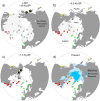Glacial vicariance drives phylogeographic diversification in the amphi-boreal kelp Saccharina latissima
- PMID: 29348650
- PMCID: PMC5773594
- DOI: 10.1038/s41598-018-19620-7
Glacial vicariance drives phylogeographic diversification in the amphi-boreal kelp Saccharina latissima
Abstract
Glacial vicariance is regarded as one of the most prevalent drivers of phylogeographic structure and speciation among high-latitude organisms, but direct links between ice advances and range fragmentation have been more difficult to establish in marine than in terrestrial systems. Here we investigate the evolution of largely disjunct (and potentially reproductively isolated) phylogeographic lineages within the amphi-boreal kelp Saccharina latissima s. l. Using molecular data (COI, microsatellites) we confirm that S. latissima comprises also the NE Pacific S. cichorioides complex and is composed of divergent lineages with limited range overlap and genetic admixture. Only a few genetic hybrids were detected throughout a Canadian Arctic/NW Greenland contact zone. The degree of genetic differentiation and sympatric isolation of phylogroups suggest that S. latissima s. l. represents a complex of incipient species. Phylogroup distributions compared with paleo-environmental reconstructions of the cryosphere further suggest that diversification within S. latissima results from chronic glacial isolation in disjunct persistence areas intercalated with ephemeral interglacial poleward expansions and admixture at high-latitude (Arctic) contact zones. This study thus supports a role for glaciations not just in redistributing pre-existing marine lineages but also as a speciation pump across multi-glacial cycles for marine organisms otherwise exhibiting cosmopolite amphi-boreal distributions.
Conflict of interest statement
The authors declare that they have no competing interests.
Figures






References
-
- Hewitt GM. Some genetic consequences of ice ages, and their role, in divergence and speciation. Biol. J. Linn. Soc. 1996;58:247–276. doi: 10.1111/j.1095-8312.1996.tb01434.x. - DOI
Publication types
MeSH terms
Substances
LinkOut - more resources
Full Text Sources
Other Literature Sources

